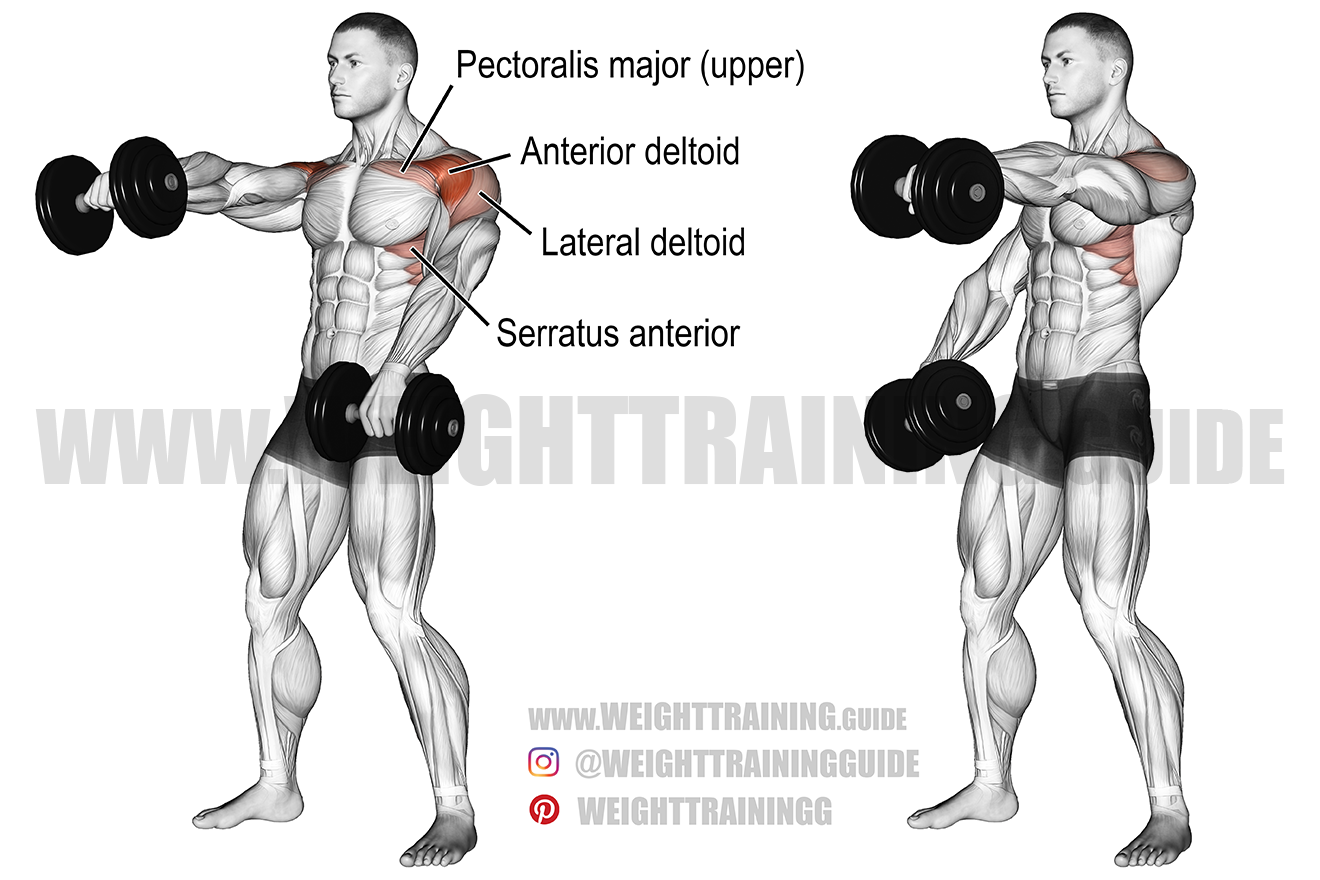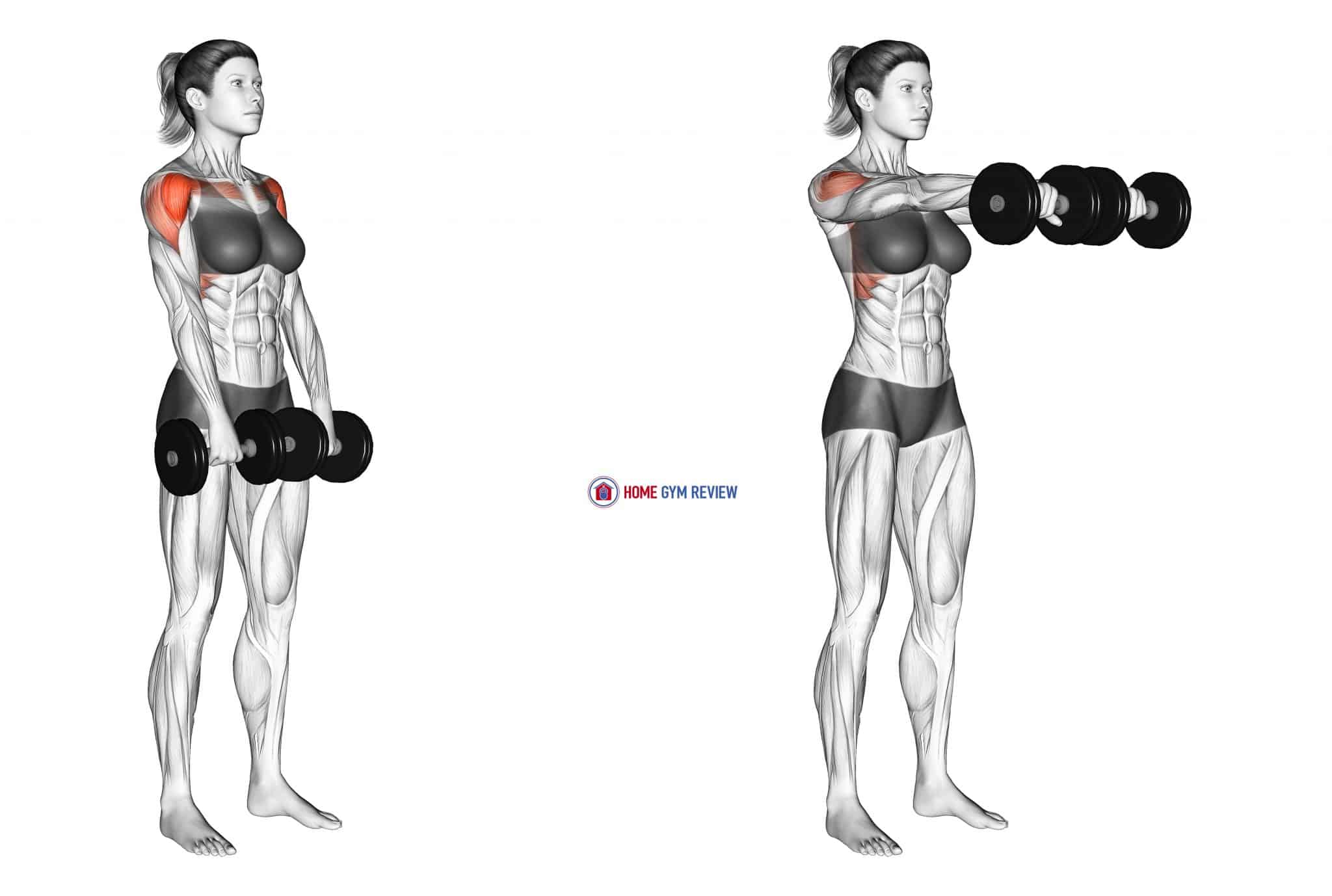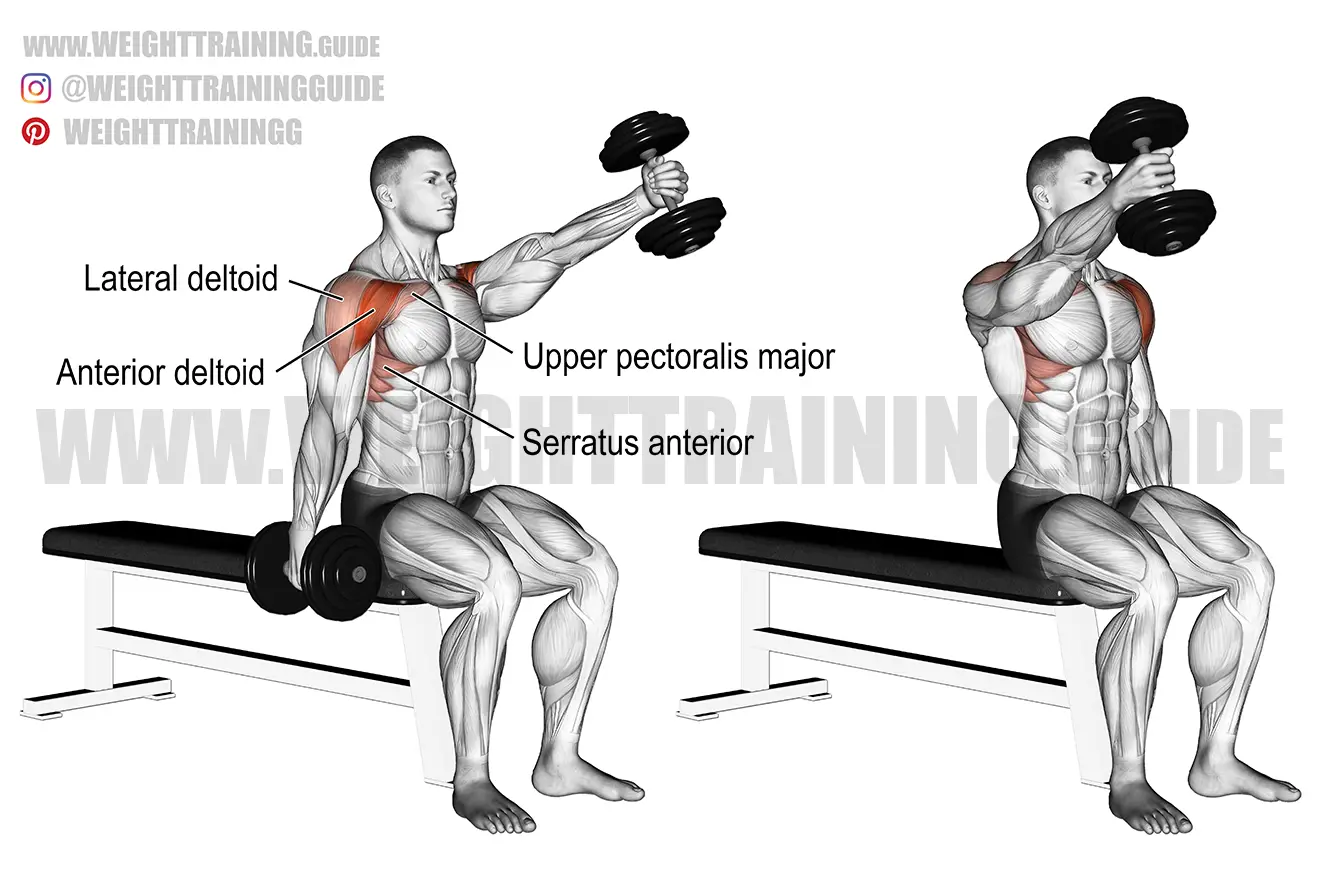Dumbbell Front Raise - Build Stronger Shoulders
Getting your shoulders in tip-top shape can feel like a big puzzle, yet it's almost always worth the effort. Many folks are looking for ways to make their upper body feel stronger and look a bit more defined, and there are plenty of moves out there that can help with just that. One particular exercise that often comes up in conversations about building those round, capable shoulders is the dumbbell front raise. It's a straightforward motion, and when you do it with care, it can really help your shoulders grow.
This simple lifting exercise, where you bring weights up in front of your body, is a common sight in many workout spaces, and for good reason. It's pretty good at targeting a specific part of your shoulder, which helps with both how your shoulders look and how well they can do their job every day. You see, a lot of what we do with our arms, like reaching for something on a high shelf or putting a bag away, calls on these very muscles. So, learning a little more about this move, and how to do it without causing any discomfort, could be a real help for your routine.
We're going to take a closer look at this particular movement, giving you some pointers on how to get it right and what good things might come from adding it to your regular physical activity. It’s a way to work on the front of your shoulders, which, you know, are pretty important for lots of actions. Plus, we'll talk about how to make sure you're doing it in a way that feels good and keeps your shoulders feeling happy. It's really about making your time with the weights count for something.
Table of Contents
- What's the Big Deal with the Dumbbell Front Raise?
- How Does the Dumbbell Front Raise Help Your Shoulders?
- Getting Started - Your First Dumbbell Front Raise
- Are There Ways to Change Up Your Dumbbell Front Raise?
- Why Pay Attention to Your Dumbbell Front Raise Form?
- What Muscles Get to Work with the Dumbbell Front Raise?
- Benefits of the Dumbbell Front Raise for Everyday Life
- Step-by-Step for the Standing Dumbbell Front Raise
What's the Big Deal with the Dumbbell Front Raise?
Well, for starters, this particular exercise, the dumbbell front raise, is what some folks call an "isolation" movement. That means it's pretty focused on working just one main muscle group, which, in this instance, is the front part of your shoulder. It's like shining a spotlight on that one area to give it some special attention. When you lift those weights straight out in front of you, your body is doing a specific action that makes that front shoulder muscle really do the heavy lifting, so to speak. It's a very direct way to give those shoulder muscles a good workout.
This kind of movement is a bit different from exercises where lots of different muscles are working all at once, like when you push something heavy overhead. With the dumbbell front raise, the idea is to really zero in on that one area. This can be quite useful if you're trying to make that specific part of your shoulder stronger or give it a bit more shape. It’s a simple action, just raising the weights up and then bringing them back down, but that simplicity lets you really feel the muscle doing its job. Many people find this focused approach to be quite effective for their goals.
When you add this sort of exercise into your routine, you are, in a way, giving your shoulders a chance to get stronger in a very particular motion. It's not just about looking good, though that can be a nice bonus. It's also about making those muscles more capable. The front of your shoulder, which this move works, is involved in a surprising number of arm movements, especially those where you bring your arm up in front of your body. So, strengthening it with the dumbbell front raise can have some good ripple effects on how your arms feel and perform in general.
How Does the Dumbbell Front Raise Help Your Shoulders?
The main muscle that gets a good workout from the dumbbell front raise is the anterior deltoid. This is the part of your shoulder muscle that sits right on the front, kind of like the cap of your shoulder. It plays a big role in what's called "shoulder flexion," which is just a fancy way of saying bringing your arm forward and up. Think about reaching for something on a shelf above you, or even just lifting your arm to point at something. That’s your anterior deltoid doing its thing, and this exercise really gives it a good stretch and contraction.
Beyond just bringing your arm up, this muscle also helps out a bit when you're doing other kinds of pushing movements, like when you push weights away from your body. So, by making your anterior deltoid stronger with the dumbbell front raise, you're not just improving that one specific motion. You're also, in some respects, giving a helping hand to other exercises that involve pushing. It's like building a good foundation for a whole range of upper body actions. Over time, this can lead to your shoulders feeling much more capable and robust.
When you keep at it with this exercise, doing it regularly and with good form, you can expect to see some changes in how your shoulders look and feel. They might start to appear a bit more rounded and defined, which is often what people are aiming for when they work on their shoulders. But more importantly, they'll likely become stronger, which means daily activities that involve lifting or reaching will feel a bit easier. It’s about making your body work better for you, and the dumbbell front raise is a pretty direct way to do that for your shoulders.
Getting Started - Your First Dumbbell Front Raise
So, if you're just getting started with this particular movement, or maybe you've tried it before and want to make sure you're doing it right, there are a few simple things to keep in mind. The idea is to lift the weights in a way that really focuses on the shoulder muscle without putting any unwanted stress on other parts of your body. It's about control, not just swinging the weights up. You want to make sure your shoulders feel good throughout the whole action, and that means paying a little attention to how you move.
The most important part, really, is to begin with a weight that feels manageable. You don't want to pick something too heavy, especially when you're learning the ropes, because that can make it hard to keep good form. It's better to start light and get the movement down pat. You'll be standing, with a dumbbell in each hand, and your palms facing your body. Then, the idea is to lift them straight out in front of you, keeping your arms fairly straight, but not locked out, until your hands are more or less at shoulder height.
Once your hands are up there, just about level with your shoulders, you want to pause for just a tiny moment. This little pause helps to make sure you're really using that front shoulder muscle to hold the weight, rather than just using momentum. Then, with the same control, you slowly lower the weights back down to where you started. It's not a race; the slower and more controlled you are, the more your muscles get to work. This smooth movement, both up and down, is key to getting the most out of each dumbbell front raise.
Are There Ways to Change Up Your Dumbbell Front Raise?
Yes, absolutely! The basic dumbbell front raise is a great starting point, but like many exercises, there are different ways you can do it to either make it a little easier, a little harder, or just to target the muscle in a slightly different way. The good news is that these changes are usually pretty simple and don't require a whole lot of extra equipment. It's about adjusting the way you hold the weights or the position of your body just a little bit. This can help keep your workouts interesting and also make sure you're working your shoulders in a complete way.
For instance, sometimes people will change the position of their hands or how much their elbows are bent during the lift. You can keep your elbows almost straight, or bend them just a little bit. Each small adjustment can feel a bit different and might put the focus on your shoulder in a slightly varied manner. It's about finding what feels good for your body and what helps you really feel that front shoulder muscle doing its job. These variations are there to help you continue to make progress and keep your shoulders feeling strong.
The important thing with any variation of the dumbbell front raise is to make sure you're still doing it with good form. The goal is always to work the muscle safely and effectively. So, if you try a different way of doing it and it feels uncomfortable or puts strain on your joints, then it's probably not the right variation for you at that moment. There are many ways to make this exercise work for you, and exploring these slight changes can be a good way to keep your routine fresh and keep those shoulder muscles guessing, so to speak.
Why Pay Attention to Your Dumbbell Front Raise Form?
Paying close attention to how you do the dumbbell front raise is, quite frankly, one of the most important things you can do. It’s not just about getting the weights up; it’s about getting them up in a way that helps your muscles grow stronger without causing any trouble for your shoulder joints. If you don't use good form, you might end up using other muscles to lift the weight, which means your front shoulder muscle isn't getting the full benefit. Even worse, bad form can sometimes lead to aches or pains, and nobody wants that.
When you lift the weights, you want to make sure your body isn't swinging or rocking to help the weights come up. That's a sign that the weight might be too heavy, or that you're relying on momentum rather than pure muscle power. Your body should stay pretty still, with only your arms moving. This stillness helps keep the focus right on that anterior deltoid. It's a very controlled movement, and that control is what makes it effective for building strength and definition in the front of your shoulders.
Think of it this way: good form is like the recipe for success. If you follow the steps carefully, you're much more likely to get the results you want, and your shoulders will thank you for it. It means keeping your shoulders down and back a little, not letting them creep up towards your ears. It means lifting the weights smoothly and lowering them with the same care. By doing this, you're making sure that every single dumbbell front raise you do is actually helping you get closer to your goals for stronger, more capable shoulders.
What Muscles Get to Work with the Dumbbell Front Raise?
The star of the show for the dumbbell front raise is, without a doubt, the anterior deltoid. This is the very front part of your shoulder muscle, the one that gives your shoulder that rounded look from the front. It's the primary muscle that brings your arm up and forward. When you lift those dumbbells straight out in front of you, this muscle is doing the bulk of the work, pulling your arm up against the pull of gravity. It's a very direct way to give that specific muscle group a good, focused workout.
However, while the anterior deltoid is the main worker, other muscles do get involved, even if they're playing a supporting role. For example, your upper chest muscles, sometimes called the pectoralis major, can lend a hand, especially as your arms start to come up. And the trapezius muscles, which run from the back of your head down your upper back, also help to stabilize your shoulder blades as you lift. So, it's not just one muscle working all alone, but it's definitely the anterior deltoid that's doing the lion's share of the effort during the dumbbell front raise.
This exercise is often compared to a lateral raise, which works the side part of your shoulder, but the front raise specifically targets that front portion. By working these muscles, you're helping to build strength and stability right in the top of your arms and around your shoulder joint. This can contribute to making your shoulders feel more solid and capable in various movements. It's a good way to make sure that the front part of your shoulder is getting the attention it needs to grow and get stronger.
Benefits of the Dumbbell Front Raise for Everyday Life
Beyond just looking good or feeling stronger in the gym, the benefits of doing the dumbbell front raise regularly can really show up in your daily life. Think about all the times you reach for something. Maybe it's a box on a high shelf in the pantry, or perhaps you're putting groceries away in an overhead cupboard. These actions all involve bringing your arms up and forward, which is exactly what the anterior deltoid, the muscle worked by this exercise, helps you do. So, when that muscle is stronger, these everyday tasks start to feel much, much easier.
It's also about carrying things. Imagine picking up a child, or a bag of pet food, or even just a heavy backpack. Your shoulder muscles, including the front part, play a role in stabilizing your arm as you lift and carry. A stronger anterior deltoid means more stability and less strain when you're moving things around. You might find that you can lift and carry with more confidence and less effort, which is a pretty practical advantage to have. This kind of functional strength is what makes an exercise truly useful.
Furthermore, having strong, stable shoulders can just make you feel more capable in general. It's like having a well-built framework for your arms. When your shoulders are strong, movements that involve your arms feel more controlled and less wobbly. This can be a big confidence booster, whether you're playing a sport, doing yard work, or just going about your day. The dumbbell front raise, by strengthening that key front shoulder muscle, contributes to this overall sense of physical readiness and capability in your daily routine.
Step-by-Step for the Standing Dumbbell Front Raise
Alright, let's walk through the steps for doing the standing dumbbell front raise, so you can feel confident about your technique. It's a pretty straightforward movement, but getting the details right makes all the difference for your shoulders and for getting good results. You'll need two dumbbells, one for each hand, and a bit of space to stand comfortably. The goal is to keep the movement smooth and controlled from start to finish.
First off, you'll want to stand with your feet about shoulder-width apart, or whatever feels stable for you. Hold a dumbbell in each hand, letting your arms hang down in front of your thighs. Your palms should be facing your body, and your shoulders should be relaxed, not hunched up towards your ears. It's important to have a good, solid base before you even begin the lift. This starting position sets you up for a good, clean movement.
Now, for the lifting part. Keeping your elbows either slightly bent or almost straight, slowly raise both dumbbells up in front of you. You're aiming to bring them up until your hands are just above shoulder height, or roughly parallel to the floor. It's not about swinging them up quickly; think about pulling them up using your front shoulder muscles. Your body should remain fairly still, without leaning back or using momentum to help the weights rise. This controlled upward motion is key to really working the target muscle.
Once your hands reach that top position, pause for just a moment. This little hold helps to really engage the muscle and ensures you're not just relying on the swing. Then, with the same control you used to lift them, slowly lower the dumbbells back down to the starting position. Don't just let them drop; resist the pull of gravity on the way down. This lowering phase is just as important as the lifting phase for building strength. Once the weights are back at your sides, you've completed one repetition, and you can then repeat the movement for your desired number of times.

Alternating dumbbell front raise guide and video | Weight Training Guide

Dumbbell Front Raise (female) - Home Gym Review

Seated alternating dumbbell front raise exercise instructions and video